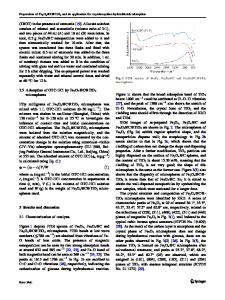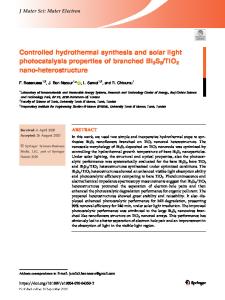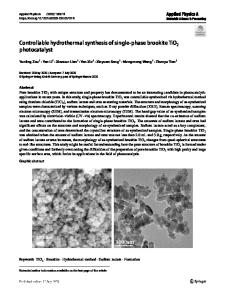Synthesis of a new visible driven photocatalyst TiO 2 / a -CNT/ b -BiOBr/ c -Bi 2 S 3 and its application for RB19 remov
- PDF / 1,680,437 Bytes
- 12 Pages / 595.276 x 790.866 pts Page_size
- 6 Downloads / 383 Views
ORIGINAL PAPER
Synthesis of a new visible driven photocatalyst TiO2/a‑CNT/b‑BiOBr/c‑Bi2S3 and its application for RB19 removal: modeling and process optimization Malihe Asadpoor1 · Mehdi Ardjmand1 · Mehrdad Farhadian2 · Mohammad Reza Omidkhah3 · Ali Akbar Zinatizadeh4 Received: 30 May 2020 / Accepted: 22 September 2020 © Institute of Chemistry, Slovak Academy of Sciences 2020
Abstract In present study, new visible driven photocatalysts (TiO2/4-CNT/20-BiOBr/10-Bi2S3) with various loading of CNT (2, 4, 6 and 8 wt%), (10, 20, 30 and 40 wt%) and B i2S3 (5, 10, 15 and 20 wt%) were successfully synthesized and characterized by XRD, FTIR, FESEM, PL, and DRS analysis. The DRS and PL analysis confirmed a redshift of modified T iO2 into a visible light range and the reduction of the recombination rate of electron/hole. The photodegradation results showed the optimum weight percentage of CNT, BiOBr, and Bi2S3 was 4%, 20%, and 10% respectively. Besides, the central composite design (CCD) was applied to model and optimize the photocatalytic activity of nanocatalyst for photodegradation of reactive blue 19 (RB19) and assess the effects of four independent variables including RB19 concentration, catalyst concentration, pH, and irradiation time on the response. The photocatalytic activity performance of TiO2/4-CNT/20-BiOBr/10-Bi2S3 under visible light irradiation for RB19 removal showed that 97.2% dye removal efficiency was obtained at optimum conditions of pH 4, catalyst dosage 1 g/L, RB19 concentration 50 mg/L, and contact time 60 min. The investigation of the effect of processing factors on the dye removal efficiency confirmed that increasing the catalyst concentration and time while decreasing pH and dye concentration resulted in the dye removal efficiency in a short time. The reusability of the catalyst was studied under optimum conditions ([RB19] = 50 mg/L, [TiO2/4-CNT/20-BiOBr/10-Bi2S3] = 1 g/L, pH = 4 and irradiation time = 60 min). Keywords CNT/TiO2/BiOBr/Bi2S3 · Visible light · Nanocomposite · Photocatalyst · Reactive blue 19
Introduction The widespread use of different types of dyes in various industries and the following discharge of untreated wastewater containing dye to aqueous environment can cause serious problems such as creating anaerobic conditions, reducing * Mehdi Ardjmand [email protected] 1
Department of Chemical Engineering, Islamic Azad University, South Tehran Branch, Tehran, Iran
2
Department of Chemical Engineering, Faculty of Engineering, University of Isfahan, Isfahan, Iran
3
Department of Chemical Engineering, Faculty of Chemical Engineering, Tarbiat Modares University, Tehran, Iran
4
Environmental Research Center (ERC), Department of Applied Chemistry, Razi University, P.O Box: 67149, Kermanshah, Iran
the sunlight penetration, cancer and allergy. Therefore, the removal of dyes and their decomposition to harmless compounds before discharging to the environment are necessary. The conventional wastewater treatment techniques are often unsuccessful in dye removal becaus
Data Loading...











